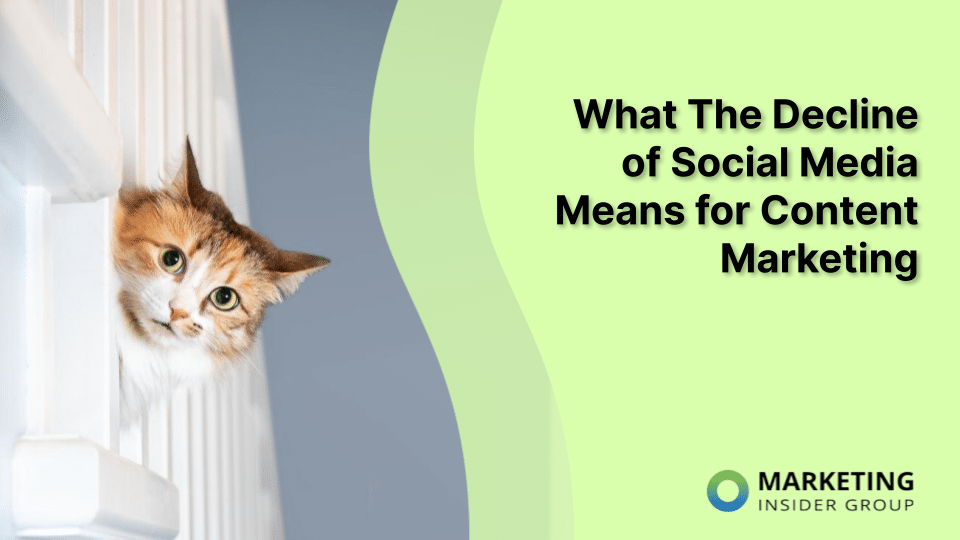
Social media isn’t the king of the castle anymore. That’s right – we’re first hand witnesses to the decline of social media as the go-to source for driving web traffic.
This isn’t just a blip on the radar. It’s a wake-up call for content marketers and publishers everywhere.
While social media platforms are still bustling with activity, boasting billions of users worldwide, there’s a twist in the plot. The way people engage with these platforms is changing, and it’s reshaping how they interact with content outside of these social bubbles, particularly in driving traffic to external sites.
In this article, we’re taking a deep dive into what this decline means for the world of content marketing. We’ll explore the factors fueling this shift, from the nitty-gritty of algorithm changes to the evolving habits of users, and how these changes are reshaping our digital marketing strategies.
Quick Takeaways
- The decline of social media as a primary driver of web traffic represents a shift in the relationship between social media platforms and content publishers.
- With the reduced efficacy of social media referrals, the focus is now shifting towards enhancing and utilizing owned content channels like websites, blogs, and email newsletters for direct audience engagement.
- Content marketers need to strategically reassess their reliance on social media, considering its decreasing ROI and exploring new methods like automation and community engagement.
- Success in content marketing now increasingly depends on adapting strategies to align with changing social media algorithms and audience preferences, and on the rising importance of quality content coupled with strategic paid content initiatives.
The Decline of Social Media Traffic
The once-thriving relationship between social media platforms and content publishers is undergoing a significant shift.
While social media continues to grow in user numbers (with over 4.80 billion people globally engaging on these platforms for an average of 2 hours and 24 minutes daily), the nature of this engagement is changing, particularly in how it drives traffic to external websites.
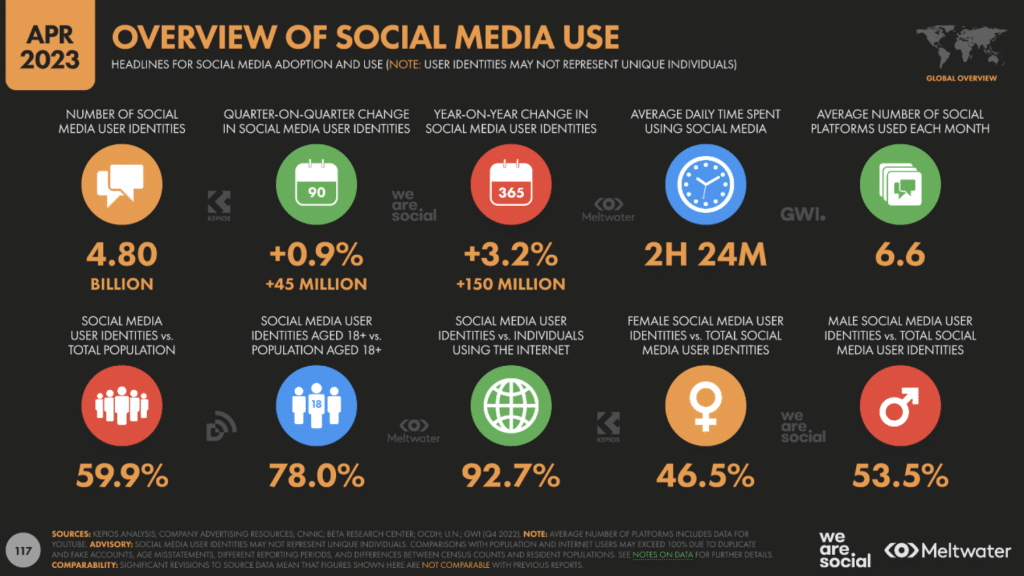
Image Source: Smart Insights
The Downward Trend in Referrals
Recent statistics indicate a marked decrease in social media referrals to news websites. For example, major publishers like The New York Times and The Guardian have seen a staggering drop of over 60% in social media referrals.
This trend is not isolated to news outlets alone. Consumer brands also report a median decline of 19.6% in organic social media referrals, painting a picture of a broader downturn across various industries.
Factors Contributing to the Decline
Several factors contribute to this decline. Algorithm changes and policy adjustments on platforms like Facebook have significantly impacted how and where content is shared.
Also, changes in user behavior, including the rise of platforms like TikTok, where external links are less common, have also played a role.
Implications for Content Marketing
For content marketers, this shift calls for a strategic reassessment. Relying on social media as a primary traffic driver is not as effective as it once was. It’s crucial to adapt to these changes, understanding that what worked in the past might not yield the same results today.
Reassessing Social Media Investment
Our research shows that, on average, social media contributes to less than 2% of a company’s website traffic.
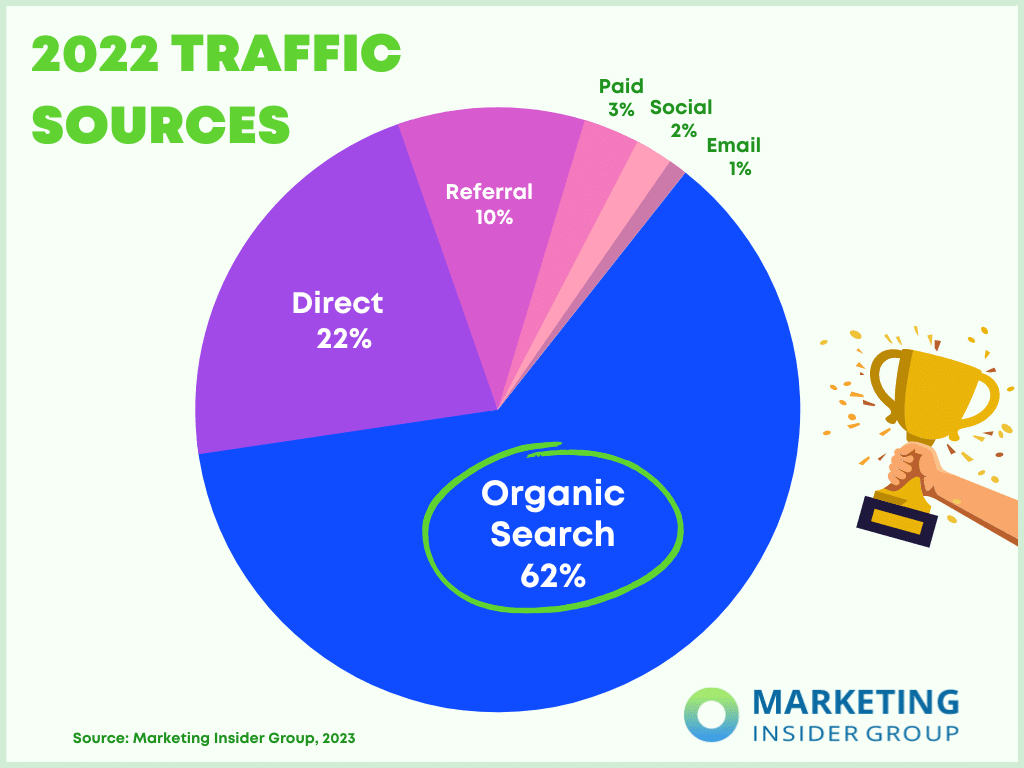
That’s a stark contrast to the high expectations many of us have had for these platforms. It raises an important question: Is our investment in social media aligning with the returns we’re seeing?
Every marketer knows the importance of ROI. When you look at the resources poured into social media – time, money, creativity – it’s crucial to measure what you’re getting back. For many, the ROI of social media might not be justifying the investment, especially when these platforms are designed more to keep users on-site rather than directing them to your website.
At Marketing Insider Group, we’re advising a strategic rethink. It’s not about abandoning social media, but rather, reassessing how we use it. We’re seeing more value in focusing on areas where our audience is actively engaging and ready to connect, which might not always be on the usual social platforms.
Strategic Shifts in Social Media Use
Adapting your strategies is key. At Marketing Insider Group, we’re seeing a shift in how social media is best used for engagement and brand visibility.
Here’s a rundown of how you can shift your approach:
1. Automate to Maximize Efficiency
Time is money, right? Automation tools are our secret weapon. They help minimize the time spent on repetitive tasks while keeping our presence active across platforms. This way, we can stay “in the conversation” without allocating excessive resources to it.
2. Content Without Links: A New Approach
Experiment with posting more content that doesn’t necessarily drive back to your site. Think jokes, quick tips, and interesting insights. It’s about engagement and brand presence, rather than direct traffic. And let’s be real – it’s refreshing not to have every post feel like a sales pitch.
3. Engaging with the Community
There’s value in joining the conversation on other people’s posts. It’s a bit like mingling at a networking event – you get to know what others are talking about, share your thoughts, and build relationships. It takes time, but it’s a genuine way to connect with your audience.
4. Paid Content Amplification
We’re putting more focus on paid content amplification. It’s like giving a megaphone to our best content pieces. With the right strategy, paid amplification can lead to significant growth and engagement, helping us reach new audiences more effectively than organic efforts alone.
Prioritizing Content Owned Channels
So, what’s the big takeaway with social media not being the golden ticket to website traffic? It’s simple. We need to focus more on what we own – our content channels. This means our
- Websites
- Blogs
- Email newsletters
When you build your presence on your own channels, you’re creating a home base.
Your website and blog are where the magic happens. This is where you can showcase your expertise, share insights, and really connect with your audience. And this way, you’re driving traffic to your space, which means more opportunities to engage with your audience in a meaningful way.
Email newsletters might seem old school, but trust us, they’re gold. Why? Because they’re direct. You’re not just another post in a crowded feed; you’re landing right in someone’s inbox. That’s personal. It’s a chance to have a one-on-one conversation with your audience.
How to Make the Most of Owned Channels
When we talk about making your owned channels work for you, outsourcing to professionals is probably your best move. Why? Because it’s not just about taking work off your plate; it’s about doing it smarter and more effectively.
- Cost-Effective and Efficient: Outsourcing content creation significantly reduces expenses compared to hiring full-time employees. It allows access to a diverse talent pool, ready to deliver high-quality, customized content efficiently.
- Quality and Speed: Outsourcing isn’t just cost-saving; it’s about quality and speed. It enables rapid scaling of content production, crucial for growing businesses, ensuring timely delivery of diverse content types.
- Hitting the Mark: Professional content creators ensure your content is effective from the start. This approach leads to content marketing generating triple the leads at 62% less cost compared to traditional marketing.
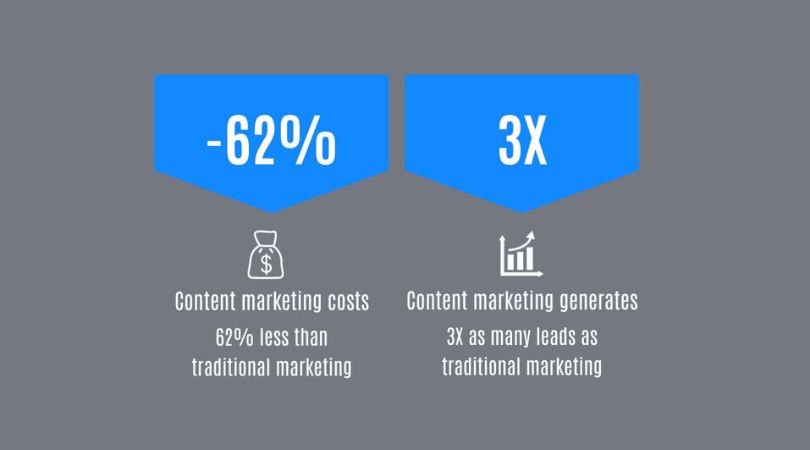
Image Source: Tomislav Horvat
In today’s digital space, outsourcing content creation is an essential strategy. It’s cost-effective, efficient, and delivers quality content that resonates with your audience. By leaving the heavy lifting to professional content creators, you can ensure that your owned channels are engaging, relevant, and impactful.
Adapting to Platform Changes and Audience Preferences
Adapting to new social media platforms and audience preferences is crucial in content marketing. As user behavior and platform algorithms change, so must our strategies. Here are key aspects to focus on:
- Utilizing Social Media Data and Insights: The success of companies is linked to their ability to harness social media data and insights. A staggering 90% of leaders agree that their company’s success hinges on effectively using social media data to inform business strategy. This highlights the importance of being data-driven in our content marketing approach.
- Staying Agile and Responsive: The dynamic nature of social media requires businesses to stay agile. This means being ready to adapt to new platforms, explore emerging trends, and adjust content strategies in response to changing user preferences and behaviors.
- Engaging with Evolving Audiences: As audiences evolve, so should the ways we engage with them. This involves understanding shifting preferences, adopting new content formats, and being present on platforms where our audience is most active.
By keeping these points in mind and staying adaptable, content marketers can effectively navigate the changing landscape of social media and audience preferences, ensuring that their strategies stay relevant and impactful.
The Rising Importance of Quality and Paid Content
As we venture further into the future of content marketing, two trends are becoming increasingly clear:
- The importance of producing high-quality content
- The strategic use of paid content
The focus on quality is more critical than ever. Nowadays, 53% of marketers are zeroing in on enhancing the quality of their content. This shift underscores a broad recognition that to truly engage audiences and stand out in the crowded digital sphere, the caliber of content must be top-notch.
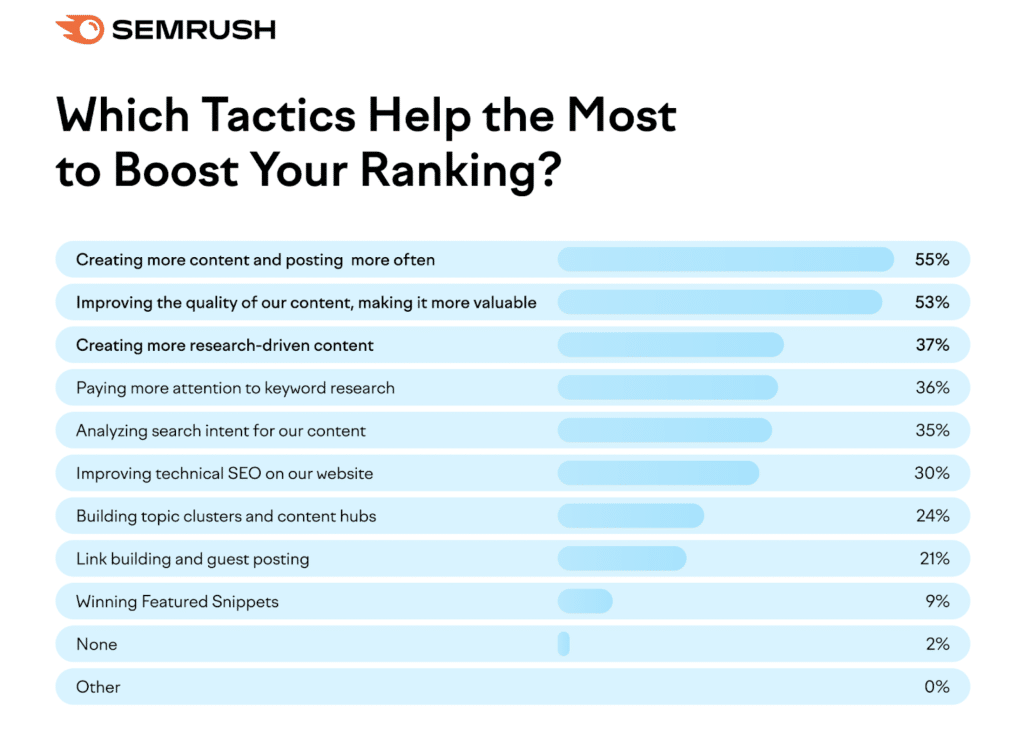
Image Source: Semrush
Simultaneously, there’s a noticeable uptick in investment in paid content strategies. Currently, 51% of marketers are channeling resources into paid social media ads.
This trend reflects an understanding that while organic content forms the backbone of content marketing, paid content is pivotal in amplifying reach and enhancing engagement. It complements organic efforts, ensuring that content not only reaches a wider audience, but also targets the most relevant segments.
The blend of high-quality content with effectively targeted paid promotions will likely become a cornerstone of successful content marketing strategies. This combination not only caters to the sophisticated preferences of today’s audiences, but also navigates the challenges of increasingly competitive digital platforms.
At the end of the day, it’s about striking the right balance – producing content that resonates and ensuring it’s seen by those who will find it most valuable.
Adapt to the New Norm: Quality Over Quantity in Content
The decline of social media as a primary source of website traffic marks a turning point in content marketing. This shift, while challenging, opens up new avenues for creativity and strategic thinking.
As we’ve seen, the key lies in adapting to platform changes, prioritizing quality content, and wisely integrating paid content strategies. By focusing on owned channels and leveraging the power of professional content creation, businesses can navigate these changes effectively.
Ready to focus on quality over quantity in content? Check out our SEO Blog Writing Service or schedule a quick consultation to learn more about how Marketing Insider Group can help you earn more leads for your business.

0 Commentaires